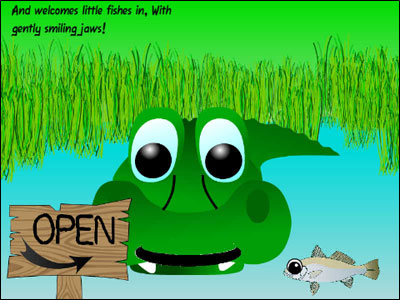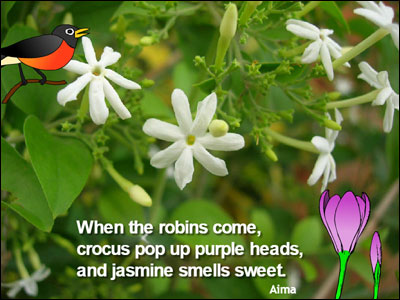Engage ELLs in literacy-building with poetry
Build vocabulary, comprehension, and fluency at all stages of language acquisition

Because of its combination of concise and purposeful text, poetry offers English Language Learners a wide range of opportunities to build essential skills in reading and writing.
The smaller number of words in many poetic forms helps to keep language learners at early stages from being overwhelmed. Precise and purposeful word choice provides an opportunity for close reading at all stages and prompts rich vocabulary discussions as students debate multiple meanings, nuance, and author’s intent.
Visualizing poetry to build comprehension and vocabulary
Poetry provides an opportunity for close reading at all stages of language acquisition. Make this process engaging and connect language learners to descriptive vocabulary with poems that utilize powerful imagery, such as Edgar Allen Poe’s “The Bells” or “The Shark” by Edwin John Pratt.
Make close reading fun by asking learners to use the efforts of their thorough and critical reading skills to create a visual version of a poem; using images to more clearly illustrate the meaning of words and phrases.
As students work to find or create appropriate imagery they need to read, reread, and analyze the words in each line of a poem. This close reading process helps language learners build fluency with the text as they work to identify and understand the meaning of the author’s words and the emotions they are trying to convey.

Student’s attempts to convey the meaning of the poem through imagery, and even music, can also help you better evaluate their comprehension, especially at early stages of language acquisition. This process also provides language learners an opportunity to demonstrate understanding without the pressure of producing oral language.
Many poems use figurative language to convey meaning through a small number of words. You might share Carl Sandburg’s “The Fog” which uses a metaphor that many language learners will understand.
Figurative language is often culturally specific, and one of the hardest skills for ELLs to acquire. You can read Paul Lawrence Dunbar’s “Sympathy” to your students and follow it up with Maya Angelou’s poem “I Know Why the Caged Bird Sings” and Alicia Keys song “Caged Bird” to show how the similar imagery is used by authors with the same cultural heritage.
Writing poetry
Along with the benefits of reading poetry, writing poetry also offers opportunities for building language acquisition. To reach your language learners you will want to be intentional in the poetry form and content you choose to have them write and provide scaffolds to help them during the writing process.
Choose a poetic form that matches your learners
Writing their own original poetry is not out of reach for ELLs, especially if you can choose a short, structured form such as acrostic or haiku.
Writing their own original poetry is not out of reach for ELLs. Take advantage of poetry forms that meet the literacy goals you have for your language learners. Many forms of poetry, such as clerihew, have a specific structure that provides direction in how to write. Other forms, like acrostic, don’t require sophisticated use of syllables or rhyme.

Haiku poetry’s 5-7-5 form requires the writer to consider syllables, providing students with an authentic context for syllable counting. You will find students clapping their hands or tapping their toes under their desks as they work to identify the correct number of syllables. Haiku poetry should also contain a “kigo,” or season word, providing an opportunity to build science vocabulary and terminology.
Use poems with repetition to encourage reading and writing fluency
Poems that use repetition are a great way to help language learners build reading fluency. You can also use these poems to support student writing by having them adapt or extend the poem.
For early-stage language learners, try a cloze-style approach to a poem adaptation or extension. For example, you can create a template that helps students write an additional verse for the Navajo chant “Twelfth Song of Thunder” from the Common Core Exemplar Texts for grades 6-8.
The voice that beautifies the land!
The voice ______, (direction preposition)
The voice of the ________(noun)
______________ (description of location)
Again and again it sounds,
The voice that beautifies the land.
The open-ended nature of this cloze-style activity gives students choice, opportunities to write at their stage or level, and makes vocabulary-building less tedious.

You can also use repetitive words and phrases to engage language learners in writing poems about the content they are learning. Take the poem “Witch, Witch” for example.
Witch, Witch, Where do you fly?
Under the clouds and over the sky.
Witch, Witch, What do you eat?
Little black apples from hurricane street.
Witch, Witch, What do you drink?
Vinegar and good red ink.
Witch, Witch, Where do you sleep?
Up in the clouds where the pillows are cheap.
Depending on the content you are studying, create a model for students that simply changes the subject of the poem to something like:
- Bear, Bear, Where do you sleep?
- Pontiac, Pontiac, Where do you sleep?
- Saturn, Saturn, Where do you sleep?
Then ask students to write a rhyming answer to each line of this 5W’s-style poem.
Even if every learner in your class is writing the same poetry form, their work is naturally differentiated by stage of language acquisition, which determines the amount of words they can access and utilize. Encourage students at higher levels of language acquisition to find words that show rather than tell to help them not only build vocabulary but develop stronger skills as writers.
Record and present poetry to build fluency
Poetry performance is a perfect opportunity to build reading and oral fluency. As they practice their poems, the repeated readings improve fluency. As speed improves, less cognitive effort is spent decoding the words, so more can be spent on comprehension. (S. J. Samuels, 1979)
You can encourage students to read poetry orally, but researchers in the field of language acquisition, like James Asher, have shown that the most effective language learning doesn’t involve any stress. Using a headset microphone, along with a digital tool like Wixie, means that students can record a reading of their poem, then immediately listen to their performance. Language learners can delete and record again, repeating this process until they are proud of the result and able to show off their fluency, without having to do it on command in front of peers.
Publish poetry for authentic literacy work
Even at early stages of language acquisition, it is important to ask students to produce meaningful work. Publishing and sharing their work not only encourages additional effort and fluency practice, it shows students that you feel their work and effort is valuable.
If students have created visual representations of existing poems, print their work so other students can connect the words and images as they read. Share these with your school’s journal or news magazine team for inclusion in an upcoming issue. You can also share their work online or through YouTube so other classrooms can use them to support their exploration of how a poem author uses word choice to paint a picture in the reader’s mind or feel a specific emotion.
If students have written their own poetry or extended an existing poem, design visual versions as well. If you have used a digital publishing tool like Wixie, export their pages as images and upload them to a photo-sharing service. Then you can publish a professional-looking coffee-table style book students can be proud to show off in your classroom or the school office.
In conclusion
Reading, analyzing, writing, and publishing poetry provides opportunities for language learners to build vocabulary and fluency at all stages of language acquisition. The structure and form of poetry lends itself to language learning classrooms whether you are building literacy skills or exploring content.
















